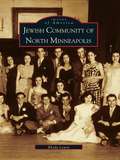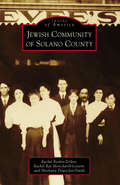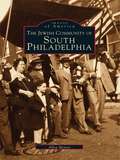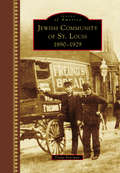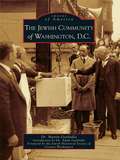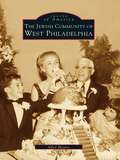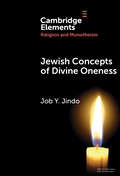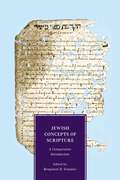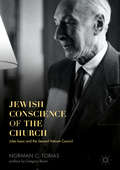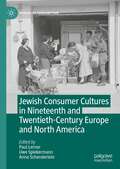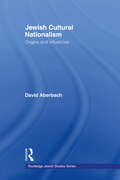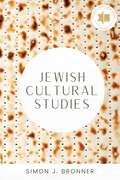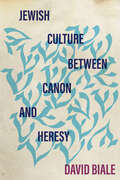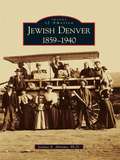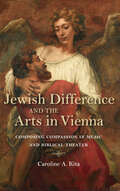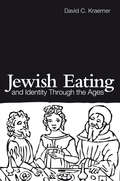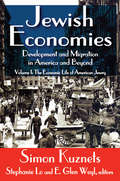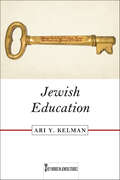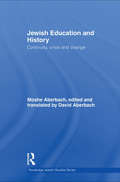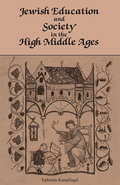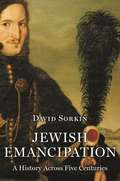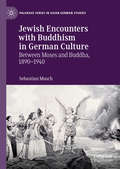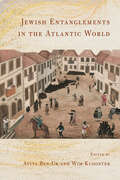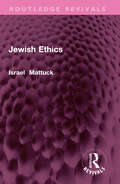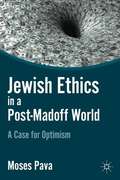- Table View
- List View
Jewish Community of North Minneapolis (Images of America)
by Rhoda LewinThe stories of the Jewish community of North Minneapolis are an important part of the rich and diverse mosaic of North Minneapolis history. By 1936, there were more than 16,000 Jew in Minneapolis, and 70 percent of them lived on the North Side. The Jewish Community of North Minneapolis presents an intriguing record of the earliest beginnings of Jewish communities in the city. Through the medium of historic photographs, this book captures the cultural, economic, political, and social history of this community, from the late 1800s to the present day. The Jews in North Minneapolis enjoyed a busy social and cultural life with their landsmanschaften, and shopped together at the kosher butcher shops and fish markets, grocery stores and bakeries, clothing stores, barber shops, restaurants, and other small businesses that had sprung up along Sixth Avenue North and then Plymouth Avenue. Including vintage images and tales of the community-Hebrew schools, synagogues, and social groups-this collection uncovers the challenges and triumphs of the Jewish community.
Jewish Community of Solano County (Images of America)
by Rachel Rae Moncharsh-Lessem Shoshana Deutscher-Nurik Rachel Raskin-ZrihenThis book contains images and stories of some of the Jews who have impacted Solano County. It is not a record of every Jew to pass this way, some of whom may have come intending to shed their Jewish identity by changing their names or converting. Wonderful stories emerged about extraordinary people who made their marks here with few suspecting their Jewish roots, yet they were traceable often because in death they chose to reclaim their heritage. Others came to live as Jews and built an enduring community. The story within these pages travels from the Old World to the edge of Gold Country, where there lives a tenacious, though often invisible, Jewish community.
Jewish Community of South Philadelphia, The: Images Of America (Images of America)
by Allen MeyersFor many Jewish immigrants to America, Philadelphia's row houses provided an instant community of neighbors where they were able to combine the traditions of the Old World with newAmerican ideals. In their flight to a new land and a new life, Jewish immigrants found a place to call home in South Philadelphia. This unprecedented collection of images celebrates the people and places of this community, from their struggles to their triumphs and the family bonds that provided their strength along the way. The Jewish Community of South Philadelphia is a tribute to tradition and pride that will serve as a valuable tool in teaching the history of Jewish immigrants in America. Join Allen Meyers in this exploration of the past that will be enjoyed for generations to come.
Jewish Community of St. Louis: 1890-1929 (Images of America)
by Diane EvermanThe St. Louis Jewish community began in the early 19th century and increased rapidly in the decades surrounding the turn of the century. Jewish immigrants brought skills and determination that helped the community evolve and prosper, but they faced challenges to survive, acculturate, and flourish. Not everyone had easy lives or great wealth, yet most worked to succeed and help others. Jewish endeavors covered all spheres, from small businesses to the Freund Bakery and Stix, Baer and Fuller Department Store to the Lesser-Goldman Cotton Company. Many garment district businesses were owned and run by Jews. Philanthropy and social betterment created the Young Men's Hebrew Association, the Jewish Sanatorium, the Home for Aged & Infirm Israelites, the Jewish Hospital, and many other entities. Members of the Jewish community proudly served in World War I and participated in clubs and organizations, as well as in political, civic, and cultural affairs.
Jewish Community of Washington, D.C., The (Images of America)
by Dr Adam Garfinkle Jewish Historical Society of Greater Washington Dr Martin GarfinkleThe Jewish community of Washington, D.C., located in the political nexus of the United States, has often enjoyed attention from people of every level of influence, including the president of the United States. On May 3, 1925, Calvin Coolidge attended the cornerstone laying ceremony of the Washington Jewish Community Center. Herbert Hoover, as a former president, was vocal in his denunciation of Nazi Germany's treatment of the Jews. His voice garnered the support of many United States senators in 1943, including two from Maryland and one from Virginia. Ronald Reagan sent his personal regards to the Ohev Shalom Talmud Torah Congregation on their 100th anniversary celebration on April 10, 1986.
Jewish Community of West Philadelphia, The: Images Of America (Images of America)
by Allen MeyersThe Jewish community of Philadelphia west of the Schuylkill River is a composite of seven distinct neighborhoods surrounding West Philadelphia proper. These include Fortieth and Girard, Parkside, Wynnefield, Overbrook Park, Wynnefield Heights, Southwest Philly, and Island Road.A gathering of seventy-five thousand Jewish people in West Philadelphia during the twentieth century qualified the area known as "a city within a city" as a second settlement area. Excellent public transportation included the famed Market Street Elevated. The West Philadelphia Jews flourished and supported dozens of synagogues and bakeries, and more than one hundred kosher butcher shops at the neighborhood's height from the 1930s through the 1950s. Newly arrived immigrants embraced traditional Jewish values, which led them to encourage their offspring to acquire a secondary education in their own neighborhoods as a way of achieving assimilation into the community at large. The Jewish Community of West Philadelphia portrays Jewish life throughout West Philadelphia in the mid-twentieth century. The book captures rare, nearly forgotten images with photographs gleaned from the community at large.
Jewish Concepts of Divine Oneness: A Comparative Introduction (Elements in Religion and Monotheism)
by Job Y. JindoThis book offers a selective, typological overview of Jewish perspectives on the belief in God's oneness. To achieve this, the author divides the history of Judaism into four phases-biblical, rabbinic, medieval, and moder-and presents diverse models for understanding the reality of divine oneness within each phase. These models not only offers insight into different perspectives on the topic but also illuminate diverse layers of polemical discourse in the Jewish tradition, whether internal or in dialogue with other religions and worldviews. In addition, the author invites readers to consider how to think about the plurality of the perspectives at hand, and if and how such meta-reflection can enrich the lives of contemporary readers, Jewish and non-Jewish alike. No prior knowledge of Judaism is necessary.
Jewish Concepts of Scripture: A Comparative Introduction
by Benjamin D SommerWhat do Jews think scripture is? How do the People of the Book conceive of the Book of Books? In what ways is it authoritative? Who has the right to interpret it? Is it divinely or humanly written? And have Jews always thought about the Bible in the same way? In seventeen cohesive and rigorously researched essays, this volume traces the way some of the most important Jewish thinkers throughout history have addressed these questions from the rabbinic era through the medieval Islamic world to modern Jewish scholarship. They address why different Jewish thinkers, writers, and communities have turned to the Bible—and what they expect to get from it. Ultimately, argues editor Benjamin D. Sommer, in understanding the ways Jews construct scripture, we begin to understand the ways Jews construct themselves.
Jewish Conscience of the Church: Jules Isaac and the Second Vatican Council
by Norman C. TobiasThis book presents the backstory of how the Catholic Church came to clarify and embrace the role of Israel in salvation history, at the behest of an unlikely personality: Jules Isaac. This embrace put to an end the tradition, more than fifteen centuries old, of anti-Jewish rhetoric that had served as taproot to racial varieties of anti-Semitism. Prior to Isaac's thought and activism, this contemptuous tradition had never been denounced in so compelling a manner that the Church was forced to address it. It is a story of loss and triumph, and ultimately, unlikely partnership. Isaac devoted his years after World War II to a crusade for scriptural truth and rectification of Christian teaching regarding Jews and Judaism. Isaac's crusade culminated in an unpublicized audience with Pope John XXIII--a meeting that moved the pope to make a last-minute addition to the Second Vatican Council agenda and set in motion the events leading to a revolution in Catholic teaching about Jews.
Jewish Consumer Cultures in Nineteenth and Twentieth-Century Europe and North America (Worlds of Consumption)
by Paul Lerner Uwe Spiekermann Anne SchenderleinThis book investigates the place and meaning of consumption in Jewish lives and the roles Jews played in different consumer cultures in modern Europe and North America. Drawing on innovative, original research into this new and challenging field, the volume brings Jewish studies and the history and theory of consumer culture into dialogue with each other. Its chapters explore Jewish businesspeople's development of niche commercial practices in several transnational contexts; the imagining, marketing, and realization of a Jewish national homeland in Palestine through consumer goods and strategies; associations between Jews, luxury, and gender in multiple contexts; and the political dimensions of consumer choice. Together the essays in this volume show how the study of consumption enriches our understanding of modern Jewish history and how a focus on consumer goods and practices illuminates the study of Jewish religious observance, ethnic identities, gender formations, and immigrant trajectories across the globe.
Jewish Cultural Nationalism: Origins and Influences (Routledge Jewish Studies Series)
by David AberbachJewish Cultural Nationalism explores the development of Jewish nationalism from the Bible to modern times, focusing on particular movements and places as well as texts which signified, or themselves brought about, change: the Bible (Hebrew prayer book), and the modern Hebrew literature, particularly in Tsarist Russia. While the influence of the Hebrew Bible alone on nationalism in individual periods has been subject to much scholarly study, the present work is unusual in its emphasis on the continuity of Jewish cultural nationalism and its influences through Hebrew texts.
Jewish Cultural Studies (Raphael Patai Series in Jewish Folklore and Anthropology)
by Simon J. BronnerJewish Cultural Studies charts the contours and boundaries of Jewish cultural studies and the issues of Jewish culture that make it so intriguing—and necessary—not only for Jews but also for students of identity, ethnicity, and diversity generally. In addition to framing the distinguishing features of Jewish culture and the ways it has been studied, and often misrepresented and maligned, Simon J. Bronner presents several case studies using ethnography, folkloristic interpretation, and rhetorical analysis. Bronner, building on many years of global cultural exploration, locates patterns, processes, frames, and themes of events and actions identified as Jewish to discern what makes them appear Jewish and why. Jewish Cultural Studies is divided into three parts. Part 1 deals with the conceptualization of how Jews in complex, heterogenous societies identify themselves as a cultural group to non-Jews and vice versa—such as how the Jewish home is socially and materially constructed. Part 2 delves into ritualization as a strategic Jewish practice for perpetuating peoplehood and the values that it suggests—for example, the rising popularity of naming ceremonies for newborn girls, simhat bat or zeved habat, in the twenty-first century. Part 3 explores narration, including the global transformation of Jewish joking in online settings and the role of Jews in American political culture. Bronner reflects that a reason to separate Jewish cultural studies from the fields of Jewish studies and cultural studies is the distinctiveness of Jewish culture among other ethnic experiences. As a diasporic group with religious ties and varying local customs, Jews present difficulties of categorization. He encourages a multiperspectival approach that considers the Jewish double consciousness as being aware of both insider and outsider perspectives, participation in ancient tradition and recent modernization, and the great variety and stigmatization of Jewish experience and cultural expression. Students and scholars in Jewish studies, cultural studies, ethnic-religious studies, folklore, sociology, psychology, and ethnology are the intended audience for this book.
Jewish Culture between Canon and Heresy (Stanford Studies in Jewish History and Culture)
by David BialeThis career-spanning anthology from prominent Jewish historian David Biale brings over a dozen of his key essays together for the first time. These pieces, written between 1974 and 2016, are all representative of a method Biale calls "counter-history": "the discovery of vital forces precisely in what others considered marginal, disreputable and irrational." The themes that have preoccupied Biale throughout the course of his distinguished career—in particular power, sexuality, blood, and secular Jewish thought—span the periods of the Bible, late antiquity, and the Middle Ages to the twentieth century. Exemplary essays in this volume argue for the dialectical relationship between modernity and its precursors in the older tradition, working together to "brush history against the grain" in order to provide a sweeping look at the history of the Jewish people. This volume of work by one of the boldest and most intellectually omnivorous Jewish thinkers of our time will be essential reading for scholars and students of Jewish studies.
Jewish Denver: 1859-1940 (Images of America)
by Jeanne E. AbramsIn 1859, during the Pike's Peak gold rush, at least 12 Jews joined the great migration to Colorado in search of gold and a brighter future. The unpredictability of mining and a growing demand for supplies encouraged many of these Jewish settlers to establish small businesses in Denver and in towns and mining camps across the state. By the early 1870s, Jewish benevolent societies and a congregation were established. Denver's dry, mild climate attracted patients with tuberculosis, and two Jewish sanatoriums were opened in the city around the beginning of the 20th century. Many of the predominantly Eastern European Jews who came in search of better health made Denver their home, thus augmenting the early Jewish population significantly. Today Jewish life flourishes in Colorado, and Jewish citizens continue to play a vital role in its culture and development.
Jewish Difference and the Arts in Vienna: Composing Compassion in Music and Biblical Theater (German Jewish Cultures)
by Caroline A. KitaThis study “brings to life a circle of writers and composers, with analyses of their major, minor . . . and forgotten works of Jewish music theater” (Abigail Gillman, author of Viennese Jewish Modernism).During the mid-19th century, the works of Arthur Schopenhauer and Richard Wagner sparked an impulse toward German cultural renewal and social change that drew on religious myth, metaphysics, and spiritualism. The only problem was that their works were deeply antisemitic and entangled with claims that Jews were incapable of creating compassionate art. By looking at the works of Jewish composers and writers who contributed to a lively and robust biblical theatre in fin de siècle Vienna, Caroline A. Kita shows how they reimagined myths of the Old Testament to offer new aesthetic and ethical views of compassion.These Jewish artists, including Gustav Mahler, Siegfried Lipiner, Richard Beer-Hofmann, Stefan Zweig, and Arnold Schoenberg, reimagined biblical stories through the lens of the modern Jewish subject to plead for justice and compassion toward the Jewish community. By tracing responses to antisemitic discourses of compassion, Kita reflects on the explicitly and increasingly troubled political and social dynamics at the end of the Habsburg Empire.
Jewish Eating and Identity Through the Ages (Routledge Advances In Sociology Ser.)
by David C. KraemerThis book explores the history of Jewish eating and Jewish identity, from the Bible to the present. The lessons of this book rest squarely on the much-quoted insight: 'you are what you eat.' But this book goes beyond that simple truism to recognise that you are not only what you eat, but also how, when, where and with whom you eat. This book begins at the beginning – with the Torah – and then follows the history of Jewish eating until the modern age and even into our own day. Along the way, it travels from Jewish homes in the Holy Land and Babylonia (Iraq) to France and Spain and Italy, then to Germany and Poland and finally to the United States of America. It looks at significant developments in Jewish eating in all ages: in the ancient Near East and Persia, in the Classical age, throughout the Middle Ages and into Modernity. It pays careful attention to Jewish eating laws (halakha) in each time and place, but it does not stop there: it also looks for Jews who bend and break the law, who eat like Romans or Christians regardless of the law and who develop their own hybrid customs according to their own 'laws', whatever Jewish tradition might tell them. In this colourful history of Jewish eating, we get more than a taste of how expressive and crucial eating choices have always been.
Jewish Economies (Volume 1): Development and Migration in America and Beyond: The Economic Life of American Jewry
by Simon KuznetsNobel Laureate Simon Kuznets, famous as the founder of modern empirical economics, pioneered the quantitative study of the economic history of the Jews. Yet until now his most important work on the subject was unpublished. These volumes bring to the public, for the first time, the most important work written on Jewish economic history since that of Werner Sombart a century ago.In the first volume, Kuznets uses extensive, original data to trace trends in the economic life of American Jews. He measures quantitatively for the first time the legendary economic success of American Jews and discusses the foundations of these achievements. Tracing their distinctive concentration in the professions, he exposes the causes of the extreme inequalities in American Jewish economic life. The immigrant origin of nearly all American Jews offers a unique case study in the process of assimilation that made American Jewry the ultimate American success story. This offers an ideal prelude to the second forthcoming volume, Comparative Perspectives on Jewish Migration.The volume's editors also provide a unique perspective on Kuznets' work. In the introduction, Weyl shows that many of Kuznets' most influential ideas, were inspired by his study of the economic history of the Jews. Through careful analysis of shared themes, and dozens of hours of detailed interviews, Lo and Weyl reveal a new dimension of Kuznets' thought to historical inquiry.
Jewish Education (Key Words in Jewish Studies)
by Ari Y KelmanMost writing about Jewish education has been preoccupied with two questions: What ought to be taught? And what is the best way to teach it? Ari Y Kelman upends these conventional approaches by asking a different question: How do people learn to engage in Jewish life? This book, by centering learning, provides an innovative way of approaching the questions that are central to Jewish education specifically and to religious education more generally. At the heart of Jewish Education is an innovative alphabetical primer of Jewish educational values, qualities, frameworks, catalysts, and technologies which explore the historical ways in which Jewish communities have produced and transmitted knowledge. The book examines the tension between Jewish education and Jewish Studies to argue that shifting the locus of inquiry from “what people ought to know” to “how do people learn” can provide an understanding of Jewish education that both draws on historical precedent and points to the future of Jewish knowledge.
Jewish Education and History: Continuity, crisis and change (Routledge Jewish Studies Series)
by Moshe AberbachMoshe Aberbach (1924-2007) was a leading educator and scholar in Jewish studies, specialising in the field of Jewish education in the talmudic period. This book draws on a representative selection of his writings over a fifty year period, and includes essays on Saadia Gaon and Maimonides, coverage of biblical and talmudic studies, and discussions of the roots of religious anti-Zionism and of the Lubavitch messianic movement in the context of similar movements in Jewish history. Focusing on the history of Jewish education and linking the Roman destruction of the Jewish state in 70 CE with Jewish survival after the Holocaust, and how survival of both depended on a strong system of education and the moral example set by teachers, the book explores the vital importance of education to Jewish survival from biblical times to the present. The book includes an autobiographical memoir of Moshe Aberbach’s childhood in Vienna, as well as a biographical Foreword by his son, David. It will be of great interest to Bible scholars and students of Jewish Studies, History, the Holocaust and Jewish social psychology.
Jewish Education and Society in the High Middle Ages
by Ephraim KanarfogelPaperback edition of a favorite text on the literary creativity and communal involvement in the production of the Tosafist corpus.
Jewish Emancipation: A History Across Five Centuries
by David SorkinThe first comprehensive history of how Jews became citizens in the modern worldFor all their unquestionable importance, the Holocaust and the founding of the State of Israel now loom so large in modern Jewish history that we have mostly lost sight of the fact that they are only part of—and indeed reactions to—the central event of that history: emancipation. In this book, David Sorkin seeks to reorient Jewish history by offering the first comprehensive account in any language of the process by which Jews became citizens with civil and political rights in the modern world. Ranging from the mid-sixteenth century to the beginning of the twenty-first, Jewish Emancipation tells the ongoing story of how Jews have gained, kept, lost, and recovered rights in Europe, North Africa, the Middle East, the United States, and Israel.Emancipation, Sorkin shows, was not a one-time or linear event that began with the Enlightenment or French Revolution and culminated with Jews' acquisition of rights in Central Europe in 1867–71 or Russia in 1917. Rather, emancipation was and is a complex, multidirectional, and ambiguous process characterized by deflections and reversals, defeats and successes, triumphs and tragedies. For example, American Jews mobilized twice for emancipation: in the nineteenth century for political rights, and in the twentieth for lost civil rights. Similarly, Israel itself has struggled from the start to institute equality among its heterogeneous citizens.By telling the story of this foundational but neglected event, Jewish Emancipation reveals the lost contours of Jewish history over the past half millennium.
Jewish Encounters with Buddhism in German Culture: Between Moses and Buddha, 1890–1940 (Palgrave Series in Asian German Studies)
by Sebastian MuschIn Germany at the turn of the century, Buddhism transformed from an obscure topic, of interest to only a few misfit scholars, into a cultural phenomenon. Many of the foremost authors of the period were profoundly influenced by this rapid rise of Buddhism—among them, some of the best-known names in the German-Jewish canon. Sebastian Musch excavates this neglected dimension of German-Jewish identity, drawing on philosophical treatises, novels, essays, diaries, and letters to trace the history of Jewish-Buddhist encounters up to the start of the Second World War. Franz Rosenzweig, Martin Buber, Leo Baeck, Theodor Lessing, Jakob Wassermann, Walter Hasenclever, and Lion Feuchtwanger are featured alongside other, lesser known figures like Paul Cohen-Portheim and Walter Tausk. As Musch shows, when these thinkers wrote about Buddhism, they were also negotiating their own Jewishness.
Jewish Entanglements in the Atlantic World
Jewish Entanglements in the Atlantic World represents the first collective attempt to reframe the study of colonial and early American Jewry within the context of Atlantic History. From roughly 1500 to 1830, the Atlantic World was a tightly intertwined swathe of global powers that included Europe, Africa, North and South America, and the Caribbean. How, when, and where do Jews figure in this important chapter of history? This book explores these questions and many others. The essays of this volume foreground the connectivity between Jews and other population groups in the realms of empire, trade, and slavery, taking readers from the shores of Caribbean islands to various outposts of the Dutch, English, Spanish, and Portuguese empires.Jewish Entanglements in the Atlantic World revolutionizes the study of Jews in early American history, forging connections and breaking down artificial academic divisions so as to start writing the history of an Atlantic world influenced strongly by the culture, economy, politics, religion, society, and sexual relations of Jewish people.
Jewish Ethics (Routledge Revivals)
by Israel I. MattuckFirst published in 1953 Jewish Ethics presents a systematic account of ethics in Judaism. The main sources for a study of Jewish ethics are the Bible and Talmud. Rabbi Israel Mattuck discusses themes like theory of Jewish ethics; man and his moral freedom; ethical element in messianism; guides to righteousness; justice and love; truth and peace; social ethics; the judgment on war; ideas of marriage, family and divorce; and asceticism and the good life, without getting into comparisons between ethics of Judaism and of other religions. This compact book is a must read for scholars of Judaism, religion, and history of Judaism.
Jewish Ethics in a Post-Madoff World
by Moses PavaMoses Pava explores new and alternative ways of relating to Jewish texts and concepts. In doing so, he invents a nuanced, flexible, and sufficiently sensitive vocabulary to conduct productive ethical dialogues, both within and between communities.
